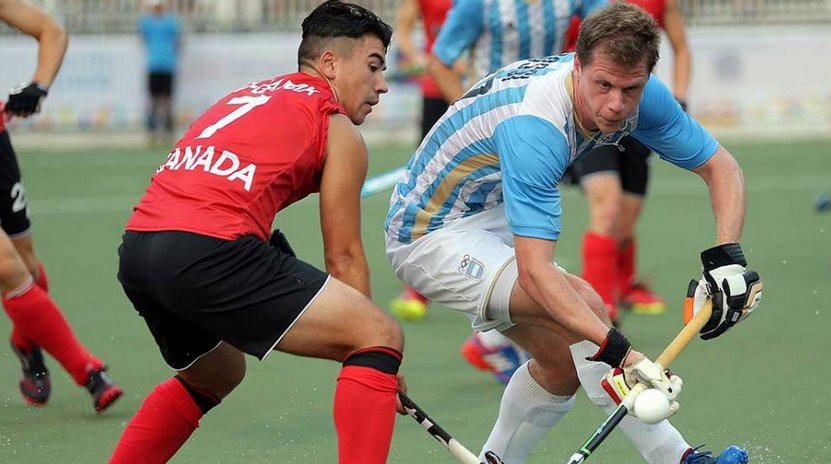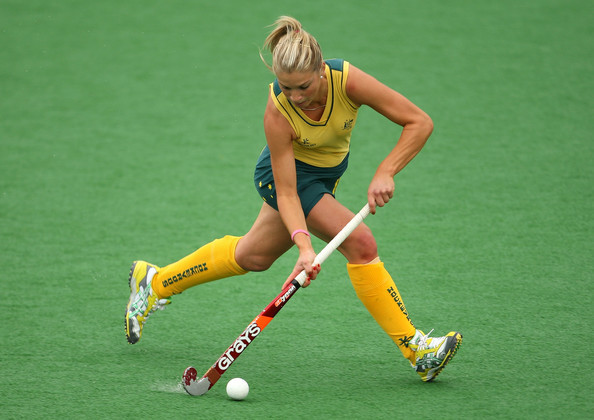Last Updated on March 30, 2025 by Andy
Playing field hockey requires a lot of physical endurance for both boys and girls. But it also requires intense mental endurance. Understanding the basic field hockey terminology, most used sayings, and critical terms used on the pitch will make you a better player…. Hands down!
Below you’ll find an alphabetical list of the field hockey terms. So good luck on the pitch, we hope the encouragement from these field hockey terms help defense and goalies alike.
Basic Field Hockey Ground Terms
Understanding the key terms and markings on a field hockey field, such as the long corner, side line, and back line, is essential for players and fans alike to fully grasp the flow and rules of the game.

Complete List of the Top Field Hockey Terms, Slang, and Sayings
A
Advantage – an undefined amount of time in which you can “play on” from a penalty.
Angry whistle – a certain tone achieved by an umpire to warn all players, usually for physical infringements.
Airswing – an attempt to hit the ball but completely missing it.
Arse – a goal that contained more luck than skill.
Astroturf – artificial grass that makes up the field. Is akin to playing on wet carpet.
B
Back-of-the-stick – the rounded side of the hockey stick. Use of this side results in a penalty, and makes the player look a bit stupid.
Backstick – to hit the ball with the flat side of your stick from the left side of your body.
Ball – small, hard thing that really hurts when it hits you.
Belly time – significant amount of diving.
Bow – the slight bend in the shaft of your stick.
Budgie – an air-swing when trying to hit the ball.
C
Cherry picker – an attacking player who doesn’t move from the spot but will claim every goal scored as their own.
Chip – a hit pass or shot at goal in which the ball becomes airborne.
Cone – a slow or ineffective defender.
Cross – a hit across the goal circle looking for a deflection.
Crook – an old-style hockey stick with a long hook.
Crumbs – a loose ball in the goal circle following a save from the goalkeeper.
D
Defence – players in the fullback, half line and goalkeeper positions.
Deflection – a one-time touch on the ball to change its course.
Drag – to fool an opposition player by quick ball movement to yourself.
Drag-flick – a raised push that reaches high-velocity speed.
Dribble – (1) to maintain control of the ball whilst running or (2) what comes out of the umpire’s mouth.
E
Eskimo Pie – a mouthguard that has been dropped onto a sand-based pitch.
F
Face-mask – protective equipment worn by defenders on short-corners.
Fall-away – set play that floods the defensive half with players, but allows the attacking team field position.
Field – the big green thing that you play hockey on. Also known as the “pitch.”
First one – an excuse given by an umpire because they missed an obvious penalty.
Flat – a pass or hit that travels quickly along the ground.
Flat-stick tackle – when a defender puts their stick parallel to the ground and waits for an attacker to run into it.
Flick – a raised push.
Foot – penalty given if the ball hits any part of a player’s body (usually the foot).
Forestick – the flat side of the stick on the right side of the body.
G
Goal – (1) the act of scoring or (2) the physical structure at each end of the field, comprised of goal posts, crossbar, backboard and net.
Goal circle – otherwise known as the “circle” or “D”, it is the area in which a ball must be touched by an attacking player before a goal can be awarded. Also the area in which goalkeepers are confined to.
Goalkeeper – otherwise known as “goalie” or “keeper”, the goalkeeper is the only player allowed to use their body to play the ball. They are recognisable by the equivalent of a Tony Stark suit of armour that they were for protection, and the unavoidable smell that the suit attracts once it has come into contact with water.
Great save – praise for your goalkeeper for standing in the goal and getting hit by the ball.
Green card – a player receives a green card (and a two-minute send-off) for a deliberate breach of the rules. Otherwise known as “lettuce.”
Grip – part of the hockey stick that you hold. It is usually covered in tape to stop your hands from slipping.
H
Hack – a bad tackle that is designed to slow or injure the ball carrier rather than dispossess them of the ball.
Half-time hero – a player or spectator who will enter the playing field to practice during half-time of a game.
Heart breaker – a shot at goal that hits the goal post or cross bar and bounces back into the field of play.
Hit – to propel the ball by connect with it using your stick.
Hole in your stick – a ball that inexplicably escapes a simple trap.
Hook – the part of your hockey stick that is shaped like… well… a hook.
Hot behind – a warning to the ball carrier that an opposition member is chasing them. Also praise for your teammate keeping in shape.
I
Indian dribble – dribbling at speed, quickly shifting the ball from left to right, rotating the stick in your hands.
Inside-forward – positions in the midfield, otherwise known as “inners.”
J
Jink – to raise the ball high enough to overcome a flat-stick tackle.
K
Keeper – Goalkeeper.
L
Lamington – a mouthguard dropped onto a sand-based pitch (Australia / New Zealand).
Left-handed-hockey stick – a myth. No left-handed hockey sticks exist. Left-handed players must adapt to either playing right-handed or become very proficient on their backstick.
Lift – (1) to raise the ball in the air or (2) to raise the ball in the air high enough to cause danger to another player.
Long corner – a hit awarded to the attacking team that is neither long nor from a corner, but taken from a position on the 25 yard line.
M
Man on – a warning that an opposition player is close to the ball carrier.
Midfield – players in the inside-forward and centre-half positions. Often get blamed for either not defending or not attacking enough.
Minister of Defence – either the goalkeeper or an exceptional fullback.
Mousetrap – set play in which the player with possession leaves the ball behind them for a trailing teammate to take possession of.
Mouthguard – piece of plastic that protects your teeth from unwanted missiles.
N
Nut – to pass the ball (or score a goal) by hitting it between a defender’s legs.
O
Obstruction – using your body (while stationary) or stick to shield the ball from opposition players’ challenges.
One-time – a hit or pass that is made without slowing or trapping the ball.
Outside – the area on the field not within the goal circle; a favourite place for defenders to “hit ‘em.”
Overhead – a pass to a teammate via an aerial route.
P
Pads – the protective gear worn by a goalkeeper, particularly on their legs.
Pass – to promote the ball to a teammate.
Pirate fight – when two players’ sticks are locked together at the hook, and both try to pull them apart.
Press – when a group of players encircle the opposition player with the ball.
Push – a method of passing or shooting the ball.
Q
(No commonly used terms.)
R
Red card – given for repeated deliberate and dangerous play, especially violence towards opposition or the umpires, the player will likely be banned from playing while they serve a penalty. Also known as “lobster.”
Rock – a dud ball.
Roofed – a ball that hits the top of the goal net.
S
Sand-based – an astroturf pitch that has sand liberally scattered over it to reduce the need for watering. Is like playing on sandpaper made of razor blades.
Shaft – the straight part of your hockey stick between the grip and the hook.
Shin-pad / Shin-guard – plastic protective equipment worn on the lower part of your legs.
Shirt punch – an age-old Australian method of punching someone without actually punching them, by gripping the front of their shirt and using the “give” in their clothing to get enough momentum to hit them. Great in a scuffle.
Shot – an attempt to score a goal, from a hit, push or flick.
Short corner – set play resulting from a defensive infringement within the goal circle.
Show pony – someone who plays up to the crowd; a show-off. Makes simple skills look decidedly more difficult, and usually involves diving onto the ground.
Shwashwa – basically any word that is spoken with a mouthguard in place at time of speaking.
Sixteen – the top of the goal circle.
Slap – a type of hit that focuses on accuracy rather than speed. Delivered low to the ground with a horizontal swing.
Slap shot – a short-swinged shot that is usually more accidental or instinctive than intentional.
Sledge – trash talking to the opposition. Also known (in Australia) as “mental disintegration.”
Spot – place on the field from which a penalty stroke is taken from. Also known as the “seven” or the “dot”.
Square ball – a pass that by definition should travel at 90 degrees to your current position, but in reality is delivered “to that side somewhere.”
Squeeze – hitting on top of the ball with your stick, causing the ball to bounce.
Stick – that thing in your hand.
Stick check – penalty given when a player tries to tackle the ball-carrier but their sticks clash. Keeps the crowd interested.
Striker – forward positions, usually divided into “wing” and “centre.”
Stroke – a free shot at goal resulting from an infringement that would have otherwise stopped a goal from being scored.
T
Tackle – to dispossess a player of the ball, through use of your stick.
Tape – used to secure loose ends of the grip on your stick, or to protect exposed skin from abrasion or injuries. Almost every goalkeeper I’ve ever met has a roll of tape in their bag.
Third-man obstruction – an infringement where an attacking player uses a teammate not in possession of the ball as a shield from defenders. Usually results in in-team swearing.
Through ball – a pass that is pushed behind the line of defence for a teammate to run on to.
Tomahawk – reverse-stick hit, either towards the goal or as a defensive clearance hit.
Top – (1) an attempt to hit the ball but your stick grazes the top of it, resulting in a mis-hit and a source of humour for your teammates or (2) the high-end of the goal circle. A great place to take a shot at goal.
Trap – a fancy way to say that you stopped the ball by using your stick.
U
Umpire – fun police. Person with the whistle who is there to stop everyone from doing what they want to.
Unlucky – yelled at no one in particular when you disagree with an umpire’s decision.
V
(No commonly used terms.)
W
Whole ball – phrase yelled at the umpire who has deemed that the ball crossed the sideline, whereas from your vantage point, there was at least one dimple that was still on the line.
Wing – Position in the forward or striker line, usually positioned on each side of the field.
Worm burner – a hard, flat hit.
X
(No commonly used terms.)
Y
Yellow card – shown to a player for repeated offenses to slow the game down or for reckless play. The player is sent from the field for a time determined by the umpire. Also known as “cheese”, “cheddar” or “pineapple.”
Z
(No commonly used terms.)
Final Whistle
This expanded guide to field hockey terms and definitions will help you understand the game better, whether you’re a player, coach, or fan. Mastering field hockey jargon, abbreviations, and slang will enhance your knowledge and performance on the pitch!
If you would like to learn about field hockey more, feel free to check our best field hockey books!



